
- •Information Broadcasting
- •Various Business Requirements and Their Solutions
- •In one plan
- •Version
- •Increase the planned
- •Is always a field to be changed
- •Variables
- •Variable definitions into the editor
- •Issues:
- •20 Perimeter Summit Boulevard
- •Ibm, db2, db2 Universal Database, os/2, Parallel Sysplex, mvs/esa, aix, s/390, as/400, os/390, os/400, iSeries, pSeries, xSeries, zSeries, System I, System i5, System p,
Access
to Data Records
Operands
The
following syntax is use to access data records
– {key
figure, field to be changed 1, field to be changed 2, …, field
t.b.c. n}
To
read data use the operands on the right side of an equation
To
change data use the operands on the left side of an equation
You
can read and change only records that are included in the filter
You
can use the input help for
entering
operands into the editor
Note:
In contrast to BW-BPS, for BI-Integrated Planning "key figure"
SAP
AG 2007, Tips and Tricks for Formulas in BI-IP / Marc F. Bernard /
25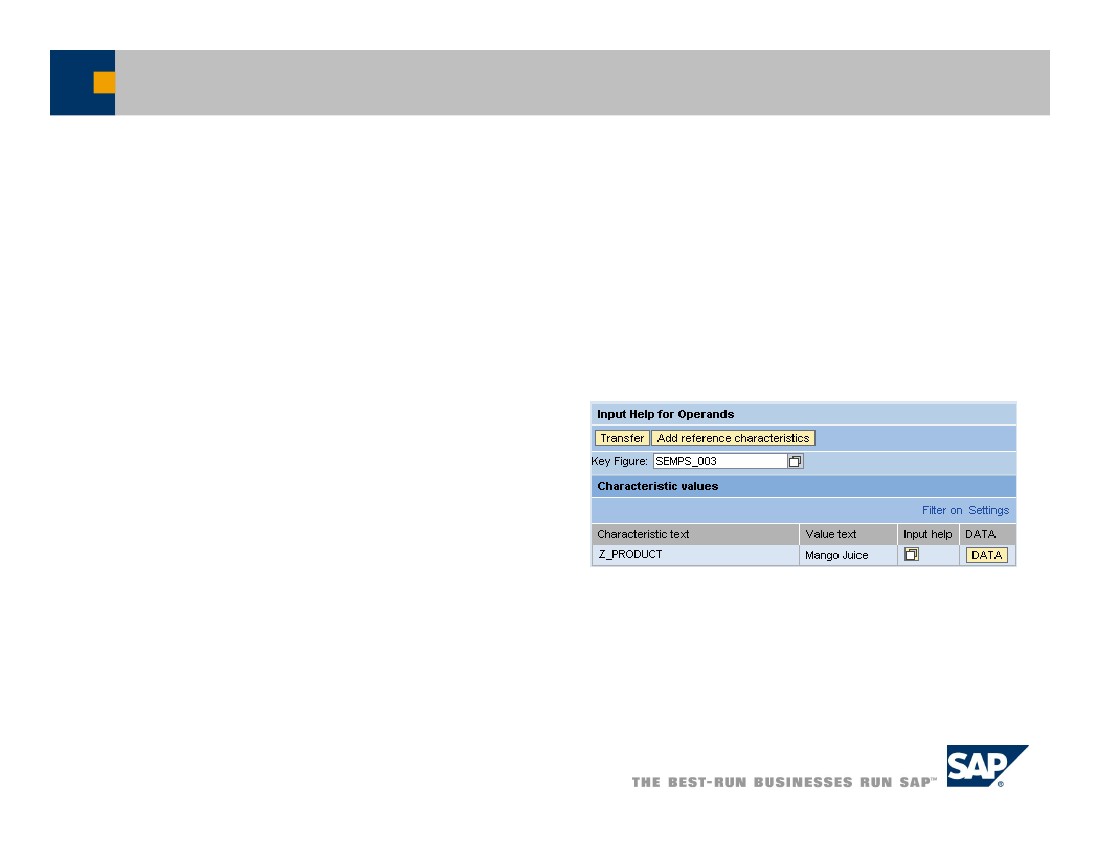
Is always a field to be changed
Access
to Data Records – Example
Example
Business
Scenario
– Copy
data for each product from the current year to the next year
Fields
to be changed
– Key
Figure, 0FISCYEAR
Formula
– {0AMOUNT,
2008} = {0AMOUNT, 2007}.
Explanation
Amount
for year 2007 is read
Amount
for year 2008 is changed
You
do not have to care about the product because of the subsets.
There's
an automatic FOREACH product done by the system.
SAP
AG 2007, Tips and Tricks for Formulas in BI-IP / Marc F. Bernard /
26
Access
to Reference Data
New
Feature
Reference
Characteristics in Operands
Business
Scenario
– We
are calculating the revenue from the planned quantities and the
prices.
Revenue
and quantity are stored in the plan version 1 whereas the prices
come
from the actual version 0.
Fields
to be changed
– Key
Figure
Formula
– {0REVENUE}
= {0QUANTITY} * {0PRICE | 0VERSION = 0}.
Explanation
Version
does not have to be in the fields to be changed but can be used
as
reference characteristic
The
filter the selection is set to version 1
SAP
AG 2007, Tips and Tricks for Formulas in BI-IP / Marc F. Bernard /
27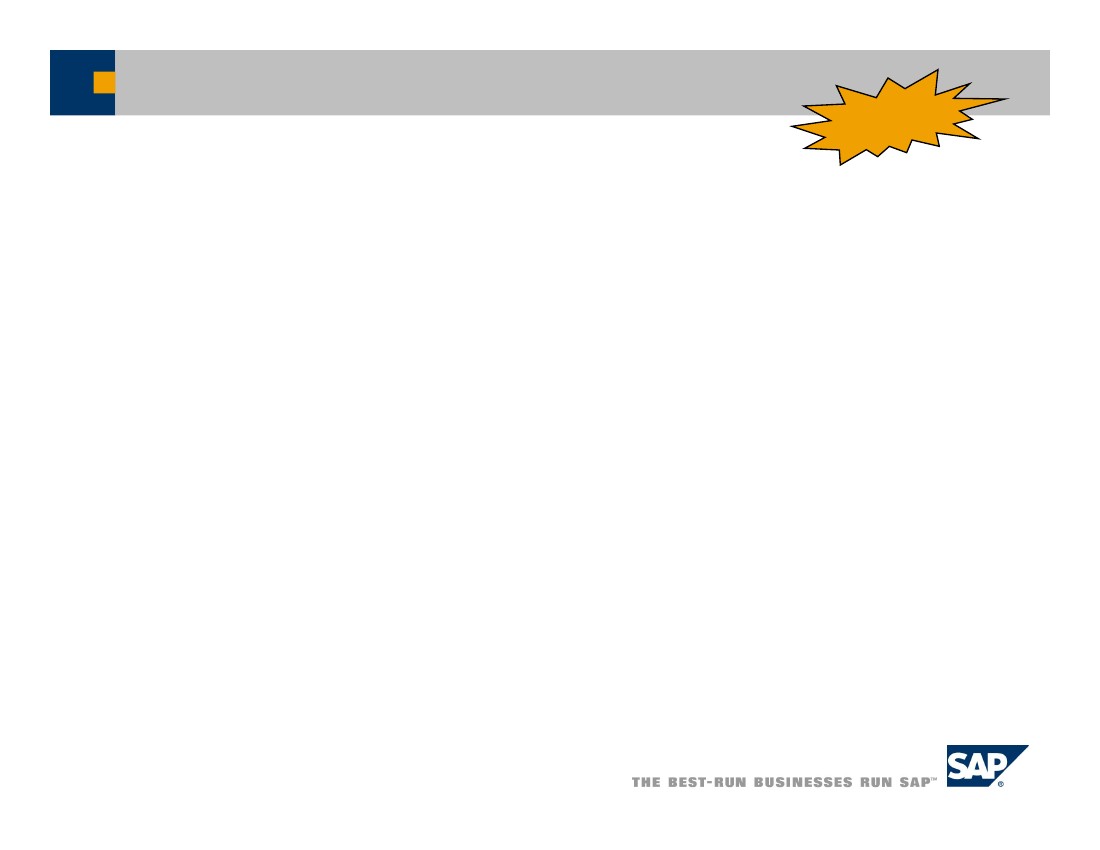
Access
to Reference Data
New
Feature
Input
Help for Operands with Reference Fields
You
can pick additional
reference
characteristics
Result
of operand in editor:
{
SEMPS_003, Apple Juice | Z_PRODLIN = Juice }
SAP
AG 2007, Tips and Tricks for Formulas in BI-IP / Marc F. Bernard /
28
Local
variables are…
used
to store temporary results
defined
using the DATA statement
always
referencing a data type
usable
only in a given formula
You
can use the input help for
Global
BI variables are…
used
to integrate with analytical engine
defined
in Planning Modeler or BEx Query Designer
referencing
characteristic or numeric values
usable
system-wide
accessed
using VARV and VARC functions
SAP
AG 2007, Tips and Tricks for Formulas in BI-IP / Marc F. Bernard /
29
Variables
Variable definitions into the editor
Loops
General
Looping
Variable
number of loops
– DO...
EXIT… ENDDO
Predefined
number of loops
– DO
n TIMES... ENDDO
Looping
over Certain Values
Plan
data values (only existing records)
– FOREACH
<Variable>... ENDFOR
Reference
data values
– FOREACH
<Variable> IN REFDATA... ENDFOR
Selection
criteria (filter)
– FOREACH
<Variable> IN SELECTION... ENDFOR
BI
Variable
– FOREACH
<Variable> IN VARIABLE... ENDFOR
New
Feature
SAP
AG 2007, Tips and Tricks for Formulas in BI-IP / Marc F. Bernard /
30
Loops
– Example
Example
Fields
to be changed
– Key
Figure, 0FISCYEAR
Formula
DATA
year TYPE 0FISCYEAR.
FOREACH
year.
{0AMOUNT,
year} = {0AMOUNT, 2007} * 1.05.
ENDFOR.
Explanation
The
values for YEAR are taken from the records in the selection
Assume
we have data records for year 2008 and 2009.
– First
loop: YEAR is replaced with 2008 and system calculates
{0AMOUNT,
2008} = {0AMOUNT, 2007} * 1.05.
– Second
loop: YEAR is replaced with 2009 and system calculates
{0AMOUNT,
2009} = {0AMOUNT, 2007} * 1.05.
SAP
AG 2007, Tips and Tricks for Formulas in BI-IP / Marc F. Bernard /
31
Conditional
Branching
Program
Flow Based on Conditions
Single
condition
– IF…
ENDIF.
Single
condition and others
– IF…
ELSE… ENDIF.
Multiple
conditions
– IF…
ELSEIF… ELSE… ENDIF.
Example
Fields
to be changed
– Key
Figure, 0FISCYEAR
Formula
IF
{0AMOUNT, 2007} > 1000.
{0AMOUNT,
2008} = {0AMOUNT, 2007} * 1.05.
ELSE.
{0AMOUNT,
2008} = {0AMOUNT, 2007} * 1.10.
ENDIF.
SAP
AG 2007, Tips and Tricks for Formulas in BI-IP / Marc F. Bernard /
32
Program
Elements
Program
Elements
Powerful
macro language
Mathematical
function library
Various
financial calculations
Access
to master data attributes
Access
to BI variables
String
operations
SAP
AG 2007, Tips and Tricks for Formulas in BI-IP / Marc F. Bernard /
33
New
Predefined Functions in Formulas
New
Feature
String
Operations
Get
part of a value
– SUBSTR
Concatenate
values
– CONCAT
Replace
a part of a value with another one
– REPLACE
Determine
length of a value
– STRLEN
Compare
values
– CP,
CO, CA, CS (contains pattern, only, any, string)
Financial
Functions
Currency
Translation
– CURC
Rounding
– ROUND
SAP
AG 2007, Tips and Tricks for Formulas in BI-IP / Marc F. Bernard /
34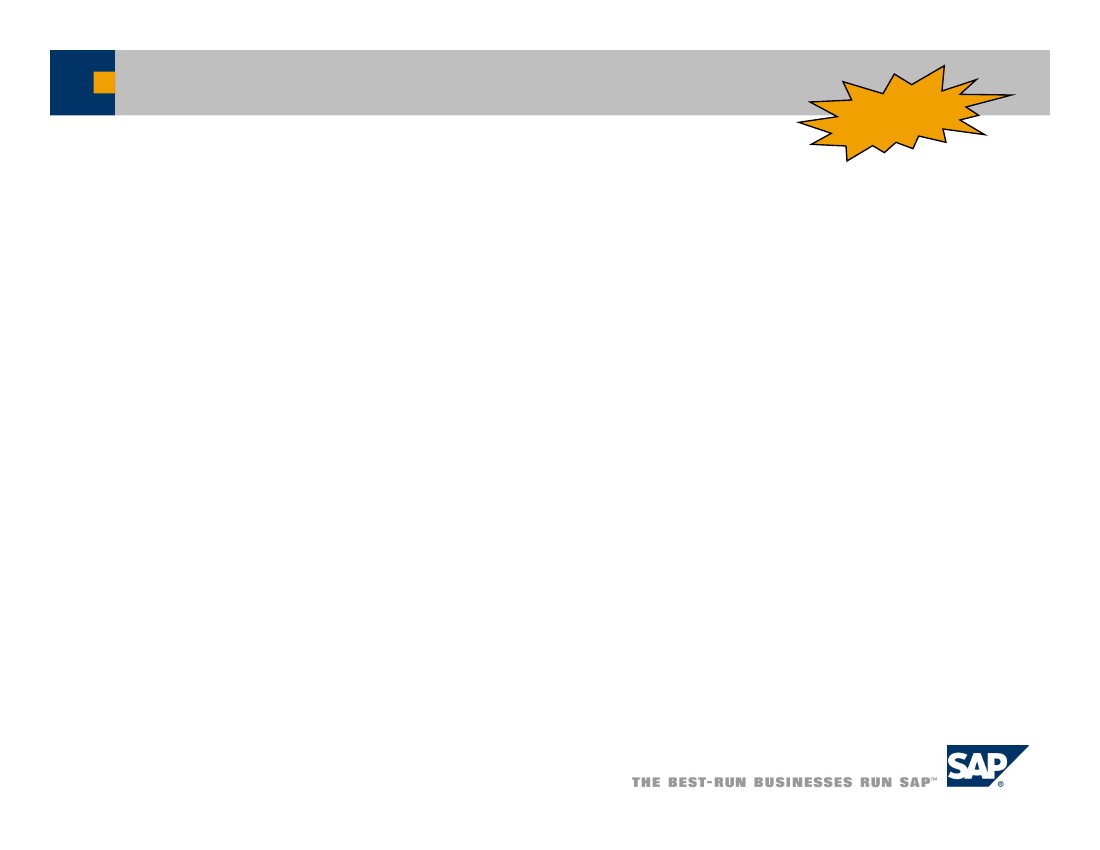
Calling
ABAP Function Modules
New
Feature
You
can call selected ABAP function modules
within
a formula
Enter
the name of the function module
in
the table RSPLF_FDIR
Use
‘CALL FUNCTION…’ in the formula
You
can use importing, exporting and
changing
parameters
Restriction
on types for parameters
– F,
I, D, or STRING
– Types
of characteristics and attributes
– No
structures or tables
If
the ABAP function module needs to raise an exception you have to
use
the construct MESSAGE...RAISING
SAP
AG 2007, Tips and Tricks for Formulas in BI-IP / Marc F. Bernard /
35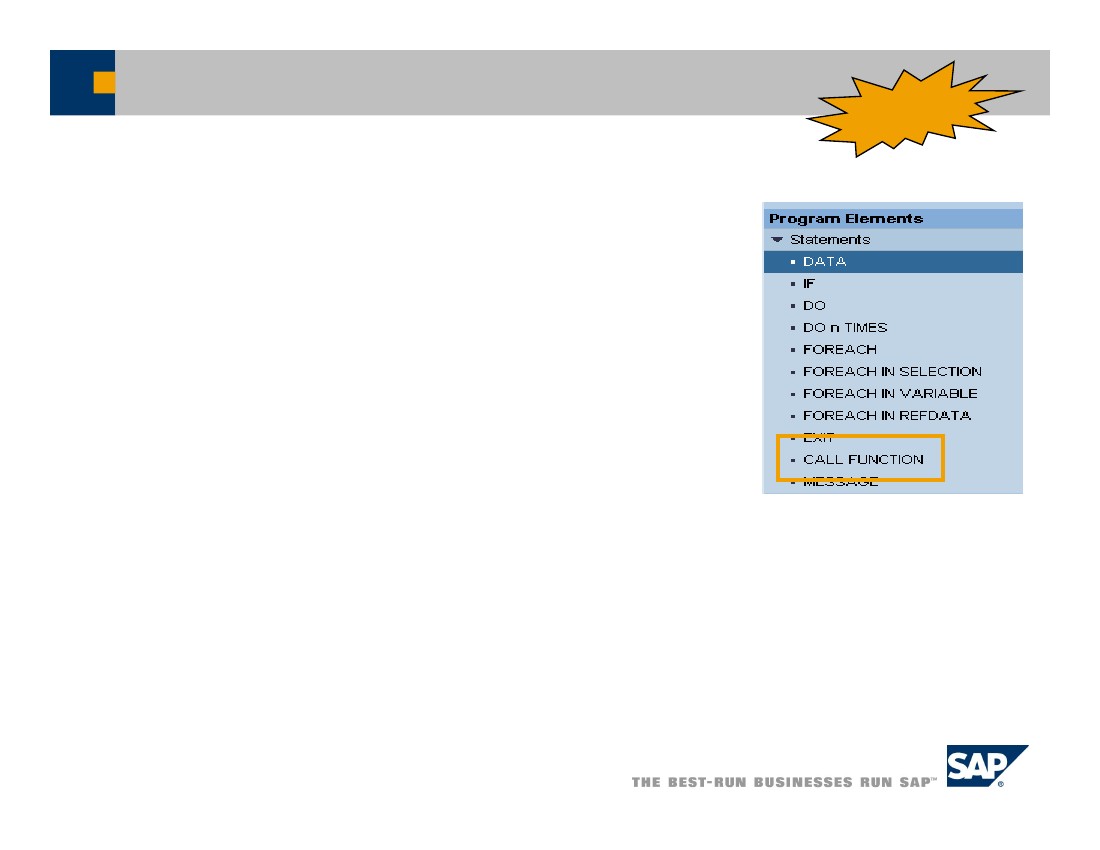
Planning
Function Types
Designing
Planning Functions
Configuring
Formulas
Performance
Tuning of Formulas
How
to Optimize Formulas (FOX)
The
idea is to reduce the complexity of the formula, without
changing
the result of the calculation.
Less
lines of FOX leads to less ABAP coding that the system has to
process
and therefore faster execution times.
There
are two main targets for optimization:
1.
Formula Operands
2.
Foreach Loops
SAP
AG 2007, Tips and Tricks for Formulas in BI-IP / Marc F. Bernard /
37
Real-world
Example
Fields
to be changed:
{
Key figure, Cost Element, Version, Planning Item, InfoProvider }
Parameter
group:
*
Cash Discount = (Base Revenue - Price Adjustment) * 2%
DATA
C TYPE 0COSTELMNT.
DATA
V TYPE 0VERSION.
DATA
P TYPE ZPLANITEM.
FOREACH
C,V,P.
{0AMOUNT,0000415001,V,CASHDISC,PA000004}
=
(
{0AMOUNT,0000400001,V,CUSTSALES,PA000004}
-
{0AMOUNT,0000410001,V,PRICADJDIS,PA000004}
+
{0AMOUNT,0000405002,V,PRICADJBKT,PA000004}
) * 0.02.
ENDFOR.
SAP
AG 2007, Tips and Tricks for Formulas in BI-IP / Marc F. Bernard /
38
Optimization
1: "Fields to be changed"
Find
all characteristics that are restricted to only one value in the
formula.
This means that the characteristic is NOT being changed
and
therefore should be remove from the "fields to be changed".
SAP
AG 2007, Tips and Tricks for Formulas in BI-IP / Marc F. Bernard /
39
Optimization
1: Example
Optimization
1: "Fields to be changed" that are not changed
Remove
from "Fields to be changed": Key figure = 0AMOUNT
Remove
from "Fields to be changed": Version = V
Remove
from "Fields to be changed": InfoProvider = 'PA000004'
Fields
to be changed:
{
Cost Element, Planning Item }
Parameter
group:
*
Cash Discount = (Base Revenue - Price Adjustment) * 2%
DATA
C TYPE 0COSTELMNT.
DATA
P TYPE ZPLANITEM.
FOREACH
C,P.
{0000415001,CASHDISC}
=
(
{0000400001,CUSTSALES}
-
{0000410001,PRICADJDIS}
+
{0000405002,PRICADJBKT}
) * 0.02.
ENDFOR.
SAP
AG 2007, Tips and Tricks for Formulas in BI-IP / Marc F. Bernard /
40
Optimization
2: "Formula selection"
Determine
the selections i.e. the characteristic combinations that
are
changed by the formula and compare it against the filter.
There
can be several cases:
Perfect
match (best case)
Filter
selection is equal to the formula selection. The system will read
only
data that is actually being changed.
Filter
selection is bigger (worst case)
The
system will read more data than required by the function.
Filter
selection is smaller (error)
The
formula potentially generates records that are not part of the
filter,
which
could lead to an error message.
SAP
AG 2007, Tips and Tricks for Formulas in BI-IP / Marc F. Bernard /
41
Optimization
2: Example
Optimization
2 A: "Formula selections (excl. reference data)" that are
different than
filter
Restrict
level/filter to formula selection: Key figure
Level/Filter:
=
0AMOUNT, ZPRICEADJ, ZUNCOLLAR
Formula:
=
0AMOUNT
Level
contains more key
figures
than necessary
Restrict
level/filter to formula selection: Cost Element
Level/Filter:
No
restriction
Formula:
=
'0000415001'
Level
is not restricted on Cost
Element
but formula changes
only
one Cost Element
Optimization
2 B: "Formula selections (incl. reference data)" that are
different than
filter
Optimization
works same way as 2A but tries to combine two database selections.
SAP
AG 2007, Tips and Tricks for Formulas in BI-IP / Marc F. Bernard /
42
Optimization
3: "Conditions"
Optimization
3 A:
If
the condition is equal to the filter restriction, then the condition
can
be removed.
Optimization
3 B:
If
there's only one condition it can be merged with the filter
selection.
SAP
AG 2007, Tips and Tricks for Formulas in BI-IP / Marc F. Bernard /
43
Optimization
4: "Formula operands"
It
is not necessary to write to the same result operand several times.
It's
also not necessary to read the same reference operand several
times.
Instead, the operands should be stored temporarily using
local
variables (DATA).
Optimization
4 A:
Based
on result data only
Optimization
4 B:
Based
on reference data only
SAP
AG 2007, Tips and Tricks for Formulas in BI-IP / Marc F. Bernard /
44
Optimization
4: Example
Fields
to be changed:
{
Material, Planning Item }
Parameter
group (BEFORE):
DATA
M TYPE 0MATERIAL.
{M,TOTALSALES}
= 0.
FOREACH
M.
{M,TOTALSALES}
= {M,TOTALSALES} + {M,CUSTSALES}.
ENDFOR.
If
there are 1,000 materials,
then
TOTALSALES has to be
read
and updated 1,000 times
Parameter
group (AFTER):
DATA
M TYPE 0MATERIAL.
DATA
TOTAL TYPE F.
TOTAL
= 0.
FOREACH
M.
TOTAL
= TOTAL + {M,CUSTSALES}.
ENDFOR.
{M,TOTALSALES}
= TOTAL.
SAP
AG 2007, Tips and Tricks for Formulas in BI-IP / Marc F. Bernard /
45
There's
only one update of
TOTALSALES
independent of
the
number of materials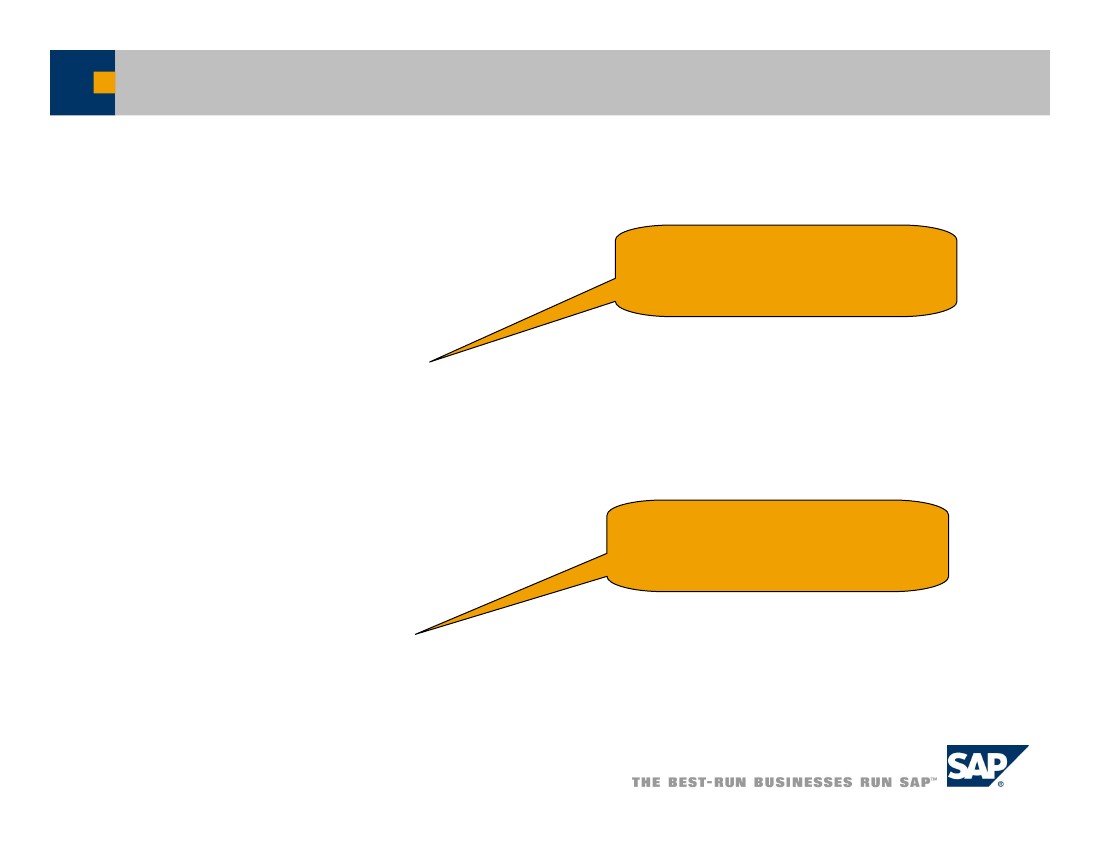
Optimization
5: "Operands in Foreach Loops"
If
an operand is used in an foreach loop but does not depend on any
foreach
variable, then the operand is being processed too often and
therefore
should be moved before (reference data) or after (result
data)
the foreach loop.
Optimization
5 A:
Based
on result data only
Optimization
5 B:
Based
on reference data only
SAP
AG 2007, Tips and Tricks for Formulas in BI-IP / Marc F. Bernard /
46
Optimization
5: Example
Fields
to be changed:
{
Cost Element, Planning Item }
Parameter
group (BEFORE):
*
Cash Discount = (Base Revenue - Price Adjustment) * 2%
DATA
C TYPE 0COSTELMNT.
DATA
P TYPE ZPLANITEM.
FOREACH
C,P.
{0000415001,CASHDISC}
=
(
{0000400001,CUSTSALES}
-
CASHDISC
is updated inside
the
loop although it does not
depend
on C or P.
{0000410001,PRICADJDIS}
+
{0000405002,PRICADJBKT}
) * 0.02.
ENDFOR.
The
other operands are read
inside
the loop although they
don't
depend on C or P.
Parameter
group (AFTER):
{0000415001,CASHDISC}
=
(
{0000400001,CUSTSALES}
-
{0000410001,PRICADJDIS}
+
{0000405002,PRICADJBKT}
) * 0.02.
Ultimately
the complete
Foreach
loop can be
removed.
SAP
AG 2007, Tips and Tricks for Formulas in BI-IP / Marc F. Bernard /
47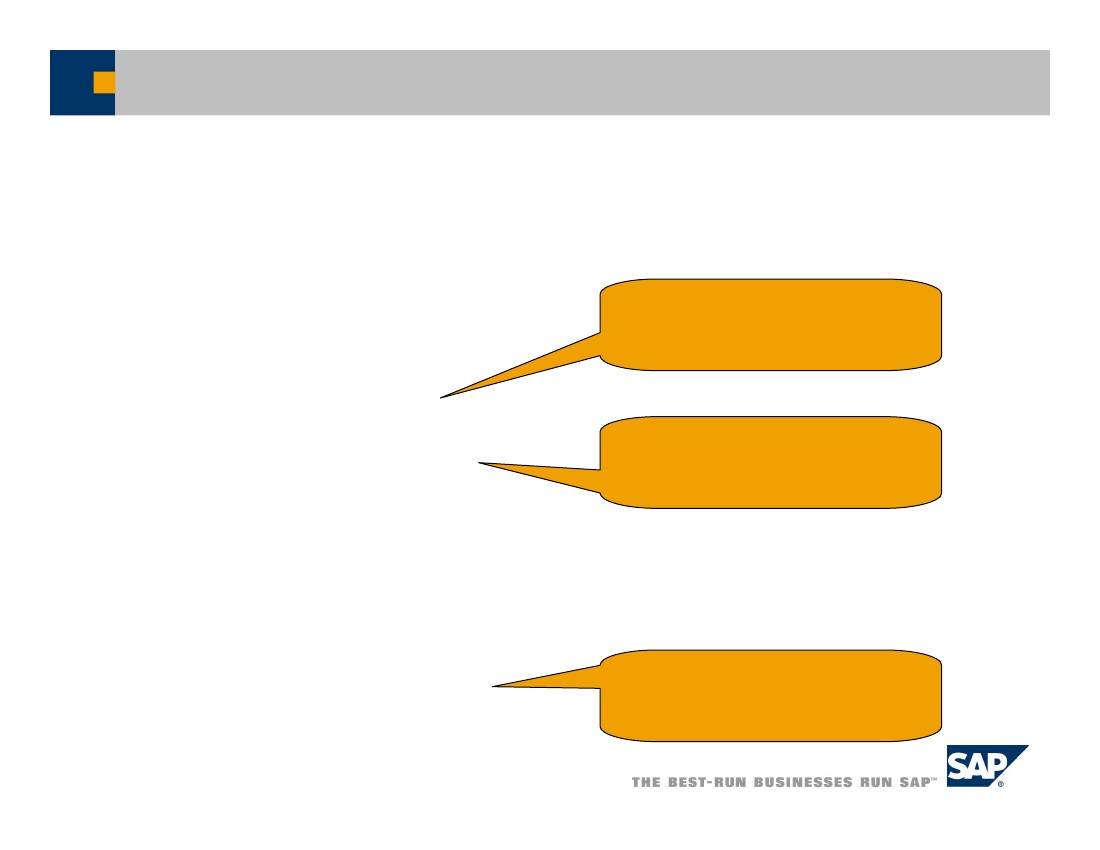
Optimization
6: "Formulas on MultiProviders"
If
the formulas is using data of only one InfoProvider but is defined
on
a MultiProvider, then the complete formula should be moved to
the
single base InfoProvider.
SAP
AG 2007, Tips and Tricks for Formulas in BI-IP / Marc F. Bernard /
48
Optimization
7: "Nested Loops"
Use
nested FOREACH statements only if necessary.
Use
FOREACH
VAR1,VAR2, ..., VARn wherever
it is possible.
Example:
Records
0PRODUCT
0001
0002
FOREACH
product.
FOREACH
year.
...
ENDFOR.
ENDFOR.
0PRODUCT
0001
0001
0002
0002
0FISCYEAR
2010
2011
2010
2011
0AMOUNT
10
0
0
20
0PRODUCT
0001
0002
0FISCYEAR
2010
2011
0AMOUNT
10
20
FOREACH
product, year.
ENDFOR.
0FISCYEAR
2010
2011
0AMOUNT
10
20
SAP
AG 2007, Tips and Tricks for Formulas in BI-IP / Marc F. Bernard /
49
Optimization
8: "If Statements"
If
Statements versus Conditions - when to use which:
When
the logic depends on variables with ranges, several values or
hierarchy
nodes, then use conditions.
When
using if-statements you only have one planning function and thus
only
one formula. Therefore the formula is easier to understand.
SAP
AG 2007, Tips and Tricks for Formulas in BI-IP / Marc F. Bernard /
50
Tip
9: "Naming Conventions"
Use
naming conventions for local FOX variables, e.g.:
CHA_…
for characteristics,
KYF_…
for key figure values,
VAR_…
for global BI variables,
ATR_...
for attributes,
INT_…
for integer numbers,
DAT_...
for dates,
TIM_...
for times.
Add
comments to the formula.
SAP
AG 2007, Tips and Tricks for Formulas in BI-IP / Marc F. Bernard /
51
Tip
9: Example
Fields
to be changed:
{
Key figure name, Posting period, Version }
*
Posting period and total amount
DATA
CHA_0FISCPER3 TYPE 0FISCPER3.
DATA
KYF_TOTAL
TYPE
F.
*
Planning version (via variable)
DATA
VAR_ZPLNVER
TYPE
0VERSION.
*
Actual period (attribute of plan version)
DATA
ATR_ZACTPER
TYPE
0FISCPER3.
*
Get actual period from plan version (via variable)
VAR_ZPLNVER
= VARV( 'ZPLNVER' ).
ATR_ZACTPER
= ATRV( 'ZACTPER', VAR_ZPLNVER ).
*
Get total to be distributed greater than actual period
KYF_TOTAL
= 0.
FOREACH
CHA_0FISCPER3.
IF
CHA_0FISCPER3 > ATR_ZACTPER.
KYF_TOTAL
= KYF_TOTAL + {0AMOUNT,CHA_0FISCPER3,VAR_ZPLNVER}.
ENDIF.
ENDFOR.
SAP
AG 2007, Tips and Tricks for Formulas in BI-IP / Marc F. Bernard /
52
Tip
10: "Reference Data"
If
you set a local variable for a characteristic using TMVL, ATRV, or
ATRVT
and use this variable in a reference data operand (right side
of
formula), then the system ignores any restrictions for this
characteristic
when reading the reference data from the database.
This
can lead to performance problems. Check the BI statistics for
long
database selection for reference data.
Try
to use the new syntax for reference data in operands:
{key
figure, field 1, field 2, …, field n | ref. field 1 = value 1,
ref. field 2 =
value
2, …, ref. field m = value m}
SAP
AG 2007, Tips and Tricks for Formulas in BI-IP / Marc F. Bernard /
53
Tip
10: Example
Fields
to be changed:
{
Company, Version }
*
Company
DATA
CHA_0COMPANY TYPE 0COMPANY.
*
Source version (attribute of company)
DATA
ATR_SVERSION TYPE SVERSION.
*
Target version (variable)
DATA
VAR_TVERSION TYPE 0VERSION.
Business
Case: Copy data
into
a target version and each
company
potentially has a
different
source version.
*
Get target version from variable
VAR_TVERSION
= VARV( 'TVERSION' ).
*
Copy data from source to target version
FOREACH
CHA_0COMPANY.
Source
version is set via attribute
(ATRV)
and then used in operand
to
read reference data.
System
will read ALL
versions
since it can't know
which
ones would be required!
ATR_SVERSION
= ATRV( 'SVERSION', CHA_0COMPANY ).
{CHA_0COMPANY,VAR_TVERSION}
= {CHA_0COMPANY,ATR_SVERSION} .
ENDFOR.
SAP
AG 2007, Tips and Tricks for Formulas in BI-IP / Marc F. Bernard /
54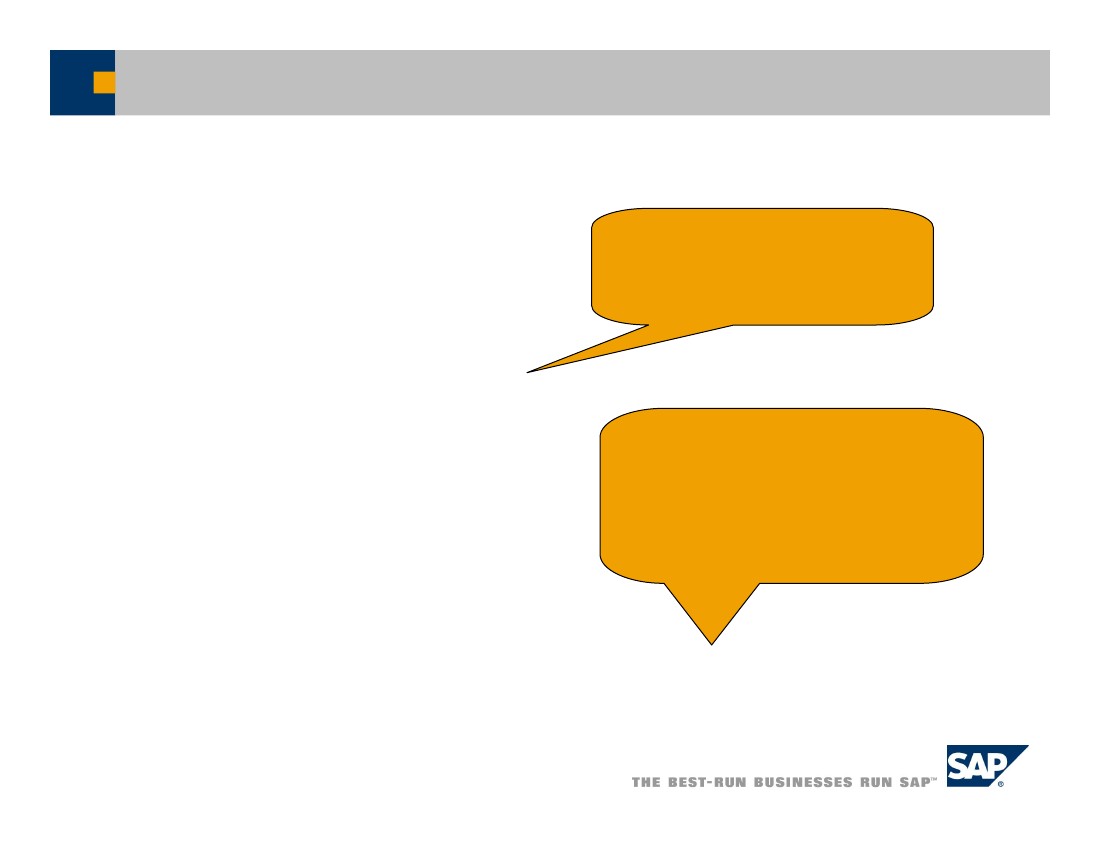
Tip
11: "Endless Loops"
Save
the formula before testing! Otherwise you loose your work if
the
program goes into an endless loop and you have to stop the
program.
To
stop a modus after having programmed an "endless loop"
(for
example
a do loop without exit statement) go to transaction SM50
and
choose Program/ModeProgramCancel.
SAP
AG 2007, Tips and Tricks for Formulas in BI-IP / Marc F. Bernard /
55
